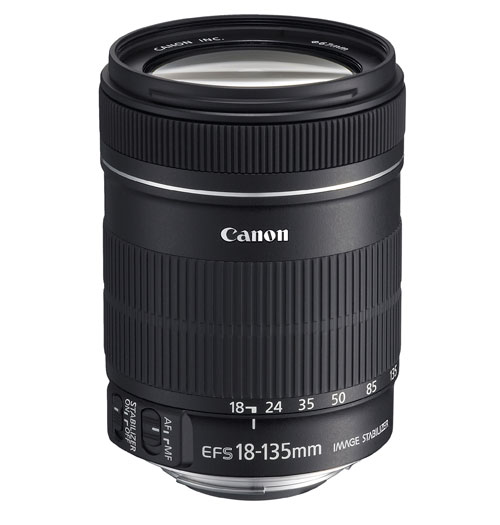Canon EF-S 18-135mm f/3.5-5.6 IS
 |
| Gary Wolstenholme takes a look at this lightweight 7.5x superzoom lens for EF-S compatible Canon cameras with Image Stabilisation. |
Canon's 18-135mm f/3.5-5.6 IS lens costs around £300 and squeezes image stabilisation and a 7.5x zoom range equivalent to 29-216mm on a 35mm camera into a lightweight and compact lens body. Being one of Canon's budget lenses, it is pretty basic. There is no ultrasonic focusing motor to speak of here but the image stabiliser promises to allow sharp shots to be taken at shutter speeds up to four stops slower than without stabilisation.
The closest alternative I could find for use on Canon cameras is Sigma's 18-200mm f/3.5-6.3 DC OS lens, which costs around £290. This lens is pretty similar in its specification except that the zoom extends to 200mm instead of stopping at 135mm, although this does cost another third of a stop in maximum aperture, which is only f/6.3 at the long end.
Canon EF-S 18-135mm f/3.5-5.6 IS: Handling and features
For a budget lens, this optic is pretty well put together. The lens barrel is constructed from texture finished plastics, which feel reasonably lightweight, but high quality. An attractive silver ring next to the focus control finishes off the lens nicely.
The zoom ring has a wide rubberised grip and is very smooth to turn with very little effort. Although there is little resistance in the zoom mechanism, I had no issues with zoom creep during testing, although I wouldn't rule it becoming an issue as the lens receives some wear and tear over time.
Focus is powered by a standard micro motor on this lens, which I find quite strange as almost every lens Canon has released recently has had an Ultrasonic motor of some description. As a result the usual benefits of fast silent focusing and full time manual focus are absent, but this is a budget lens after all. Focusing is performed internally, so polarising filters will be easy to use with this lens as the front filter does not rotate during focus or zooming.
The image stabiliser fitted to this lens promises to allow shooting at up to four stops slower than would be possible without. In use I found that I could get sharp shots with a degree of consistency at 1/8sec at 135mm which is roughly four stops slower, but to be sure I need to up the shutter speed to at least 1/15sec. The stabiliser also sports automatic panning and tripod detection to stop the stabiliser mucking up those kinds of shots.
Canon EF-S 18-135mm f/3.5-5.6 IS: Performance
Superzooms like this lens are often a compromise optically, but as far as resolution is concerned this 18-135mm from Canon is a decent performer.
At 18mm the lens is already good in the centre at maximum aperture, but as with many lenses it improves greatly when stopped down a little. Peak performance is reached at f/5.6 where the resolution in the centre is excellent, and good towards the edges of the frame. At smaller apertures diffraction begins to take a bite out of the overall sharpness, but it still performs well enough in the centre down to f/16.
At 50mm the lens is already very good in the centre at maximum aperture and the overall quality across the frame improves down to f/8, where the sharpness is very good across the frame. As with many zoom lenses overall sharpness drops off a little as the lens is zoomed in, but this lens still performs well enough at maximum aperture at 135mm. Here stopping down just one stop to f/8 finds the peak for quality at this zoom setting, where the sharpness is good across the frame.
As far as Chromatic Aberrations are concerned, this lens can be a bit lively at 18mm. Imatest recorded fringing exceeding one pixel width, and this fringing can clearly be seen along high contrast edges towards the edge of the frame. As the lens is zoomed in, colour fringing becomes less of an issue. At 50mm the levels of CA are very low indeed and at 135mm they increase again, but stay well within acceptable levels.
Falloff of illumination towards the corners may be noticeable in certain circumstances at 18mm as at maximum aperture the corners of the frame are 2.31 stops darker than the image centre. Stopping down to f/5.6 results in visually even illumination here. At 135mm falloff is much less noticeable with the corner only being 1.22 stops darker than the image centre at f/5.6. Illumination is visually even at f/8 here.
Distortion is often a weakness of superzoom lenses, and this optic is no exception. Barrel distortion at 18mm is highly noticeable. Here Imatest recorded 6.16% barrel distortion, which may pose a problem, especially in applications where straight lines are important. At 135mm pincushion distortion takes the place of the barrelling found at 18mm. However the level is much reduced with Imatest recording 1.31% pincushion distortion. This level may still be noticeable in critical applications though. Luckily the distortion pattern is uniform at both ends of the zoom range, making it a straightforward job to correct in image editing software afterwards.
When shooting images with strong light sources in the frame this lens can be quite susceptible to flare and loss of contrast, especially at 18mm. Light sources outside of the frame can also cause a myriad of brightly coloured ghosts to appear across the image area if the light strikes the front element of the lens. A lens hood would certainly help with this and Canon's EW-73B is the part required. Unfortunately it does not come supplied with the lens and will set you back a further £25 if you wish to get one.
 | DxOMark provides objective, independent, RAW-based image quality performance data for lenses and digital cameras to help you select the best equipment to meet your photographic needs. Visit the DxOMark website for tests performed on the Canon EF-S 18-135mm f/3.5-5.6 IS. |
Canon EF-S 18-135mm f/3.5-5.6 IS: Verdict
For a budget superzoom, Canon's 18-135mm isn't that bad at all. It is capable of producing images with good sharpness across the frame at optimum apertures and the Image Stabiliser works very well. Sharpness isn't everything though, and owners of this lens may want to keep the barrel distortion and chromatic aberrations at 18mm in mind when shooting.
As most people who own this lens will obtain it at a discount with a camera kit, it may represent better value than it would at the full asking price of £300. If only Canon would supply a hood with the lens rather than asking for a further £25, then some of the issues with flare would be resolved and the lens would represent even better value.
Canon EF-S 18-135mm f/3.5-5.6 IS: Pros
 Good resolution at optimum apertures
Good resolution at optimum apertures Lightweight design
Lightweight design Effective Image Stabiliser.
Effective Image Stabiliser.Canon EF-S 18-135mm f/3.5-5.6 IS: Cons
 Chromatic Aberrations at 18mm
Chromatic Aberrations at 18mm Barrel distortion at 18mm
Barrel distortion at 18mm No lens hood supplied
No lens hood supplied| FEATURES |  |
| HANDLING |  |
| PERFORMANCE |  |
| VALUE |  |
| OVERALL |  |
Canon EF-S 18-135mm f/3.5-5.6 IS: Lens specification
| Price | £300.00 |
| Contact | www.canon.co.uk |
| Filter size | 67mm |
| Format | EF-S |
| Construction | 16 elements in 12 groups |
| Angle-of-view | 74° 20' -11° 30' |
| 35mm equivalent focal length (on APS-C body) | 29-216cm |
| Internal focusing | Yes |
| Image stabilisation | Yes |
| Minimum focus | 45cm |
| Maximum aperture | f/3.5-5.6 |
| Minimum aperture | f/22-38 |
| Weight | 455g |
| Size | 75.4x101mm |
| In the box | Lens caps, bubble wrap, instructions. |
The Canon EF-S 18-135mm f/3.5-5.6 IS costs around £300 and is available from Warehouse Express here:
Canon EF-S 18-135mm f/3.5-5.6 IS
Add your message
Login required
Please login here or if you've not registered, you can register here. Registering is safe, quick and free.
Please login here or if you've not registered, you can register here. Registering is safe, quick and free.
photodo Stats
1102 lenses
428 MTF tests
74 in-depth photodo reviews
100+ users join each day
Help the lens community by reviewing or rating a lens today via our lens search
428 MTF tests
74 in-depth photodo reviews
100+ users join each day
Help the lens community by reviewing or rating a lens today via our lens search
Latest Lens Reviews
- Chinon 28mm f/2.8 Vintage Lens Review
- Canon EF 70-200mm f/4L IS II USM Lens Review
- Samyang AF 85mm f/1.4 EF Review
- Sigma 70mm f/2.8 DG Macro Art Review
- Samyang AF 24mm f/2.8 FE Review
- Meike 50mm f/1.7 Review
- Tamron 70-210mm f/4 Di VC USD Review
- Lensbaby Burnside 35mm f/2.8 Review
- Asahi Super Takumar 50mm f/1.4 Review
- Asahi Super-Multi-Coated Takumar 135mm f/3.5 Review








